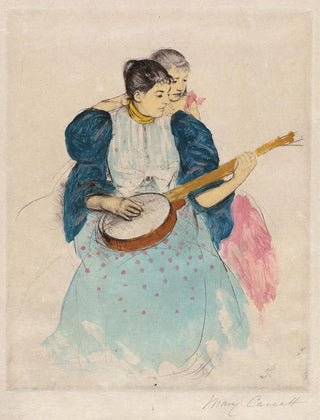Art print | The Banjo Lesson - Mary Cassatt


View from behind

Frame (optional)
Art print La leçon de banjo - Mary Cassatt – Captivating introduction
In the vibrant world of Impressionism, the artwork "La leçon de banjo" by Mary Cassatt stands out for its intimacy and delicacy. Painted at the end of the 19th century, this canvas depicts a scene from everyday life, where the bond between a mother and her child unfolds before our eyes. The soft light bathing the room, along with the delicate gestures of the characters, transports us to a suspended moment, revealing the beauty of family interactions. This piece, emblematic of feminine sensitivity in art, invites the viewer to immerse themselves in a world where love and education blend harmoniously.
Style and uniqueness of the work
Mary Cassatt, as a pioneer of Impressionist art, developed a unique style that combines finesse and expressiveness. In "La leçon de banjo," she employs light, fluid brushstrokes, creating a warm and welcoming atmosphere. The pastel colors, carefully chosen, reinforce the idea of softness and tenderness emanating from the scene. The composition, focused on the interaction between the characters, highlights the importance of family bonds. Cassatt excels in capturing subtle emotions, making each gaze and gesture meaningful. This artwork is not just a depiction of a musical lesson; it conveys a life lesson, where learning goes beyond notes and is embedded in everyday human relationships.
The artist and her influence
Mary Cassatt, born in 1844, is one of the few women to have succeeded in establishing herself in the male-dominated art world of her time. Her friendship with Edgar Degas, another prominent figure of Impressionism, profoundly influenced her work and artistic vision. Cassatt often explored themes related to motherhood and domestic life, offering a new perspective on the role of women in society. Through her works, she contributed to redefining the place of women in art, presenting them not only as subjects but also as creators of emotions and stories. Her impact extends far beyond her era, inspiring generations

Matte finish

View from behind

Frame (optional)
Art print La leçon de banjo - Mary Cassatt – Captivating introduction
In the vibrant world of Impressionism, the artwork "La leçon de banjo" by Mary Cassatt stands out for its intimacy and delicacy. Painted at the end of the 19th century, this canvas depicts a scene from everyday life, where the bond between a mother and her child unfolds before our eyes. The soft light bathing the room, along with the delicate gestures of the characters, transports us to a suspended moment, revealing the beauty of family interactions. This piece, emblematic of feminine sensitivity in art, invites the viewer to immerse themselves in a world where love and education blend harmoniously.
Style and uniqueness of the work
Mary Cassatt, as a pioneer of Impressionist art, developed a unique style that combines finesse and expressiveness. In "La leçon de banjo," she employs light, fluid brushstrokes, creating a warm and welcoming atmosphere. The pastel colors, carefully chosen, reinforce the idea of softness and tenderness emanating from the scene. The composition, focused on the interaction between the characters, highlights the importance of family bonds. Cassatt excels in capturing subtle emotions, making each gaze and gesture meaningful. This artwork is not just a depiction of a musical lesson; it conveys a life lesson, where learning goes beyond notes and is embedded in everyday human relationships.
The artist and her influence
Mary Cassatt, born in 1844, is one of the few women to have succeeded in establishing herself in the male-dominated art world of her time. Her friendship with Edgar Degas, another prominent figure of Impressionism, profoundly influenced her work and artistic vision. Cassatt often explored themes related to motherhood and domestic life, offering a new perspective on the role of women in society. Through her works, she contributed to redefining the place of women in art, presenting them not only as subjects but also as creators of emotions and stories. Her impact extends far beyond her era, inspiring generations






